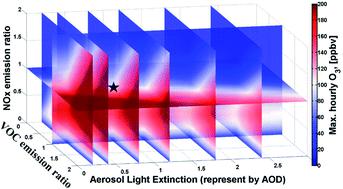当前位置:
X-MOL 学术
›
Faraday Discuss.
›
论文详情
Our official English website, www.x-mol.net, welcomes your
feedback! (Note: you will need to create a separate account there.)
Avoiding high ozone pollution in Delhi, India
Faraday Discussions ( IF 3.3 ) Pub Date : 2020-08-06 , DOI: 10.1039/d0fd00079e Ying Chen 1 , Gufran Beig , Scott Archer-Nicholls , Will Drysdale , W Joe F Acton , Douglas Lowe , Beth Nelson , James Lee , Liang Ran , Yu Wang , Zhijun Wu , Saroj Kumar Sahu , Ranjeet S Sokhi , Vikas Singh , Ranu Gadi , C Nicholas Hewitt , Eiko Nemitz , Alex Archibald , Gordon McFiggans , Oliver Wild
Faraday Discussions ( IF 3.3 ) Pub Date : 2020-08-06 , DOI: 10.1039/d0fd00079e Ying Chen 1 , Gufran Beig , Scott Archer-Nicholls , Will Drysdale , W Joe F Acton , Douglas Lowe , Beth Nelson , James Lee , Liang Ran , Yu Wang , Zhijun Wu , Saroj Kumar Sahu , Ranjeet S Sokhi , Vikas Singh , Ranu Gadi , C Nicholas Hewitt , Eiko Nemitz , Alex Archibald , Gordon McFiggans , Oliver Wild
Affiliation

|
Surface ozone is a major pollutant threatening public health, agricultural production and natural ecosystems. While measures to improve air quality in megacities such as Delhi are typically aimed at reducing levels of particulate matter (PM), ozone could become a greater threat if these measures focus on PM alone, as some air pollution mitigation steps can actually lead to an increase in surface ozone. A better understanding of the factors controlling ozone production in Delhi and the impact that PM mitigation measures have on ozone is therefore critical for improving air quality. Here, we combine in situ observations and model analysis to investigate the impact of PM reduction on the non-linear relationship between volatile organic compounds (VOC), nitrogen oxides (NOx) and ozone. In situ measurements of NOx, VOC, and ozone were conducted in Delhi during the APHH-India programme in summer (June) and winter (November) 2018. We observed hourly averaged ozone concentrations in the city of up to 100 ppbv in both seasons. We performed sensitivity simulations with a chemical box model to explore the impacts of PM on the non-linear VOC–NOx–ozone relationship in each season through its effect on aerosol optical depth (AOD). We find that ozone production is limited by VOC in both seasons, and is particularly sensitive to solar radiation in winter. Reducing NOx alone increases ozone, such that a 50% reduction in NOx emissions leads to 10–50% increase in surface ozone. In contrast, reducing VOC emissions can reduce ozone efficiently, such that a 50% reduction in VOC emissions leads to ∼60% reduction in ozone. Reducing PM alone also increases ozone, especially in winter, by reducing its dimming effects on photolysis, such that a 50% reduction in AOD can increase ozone by 25% and it also enhances VOC-limitation. Our results highlight the importance of reducing VOC emissions alongside PM to limit ozone pollution, as well as benefitting control of PM pollution through reducing secondary organic aerosol. This will greatly benefit the health of citizens and the local ecosystem in Delhi, and could have broader application for other megacities characterized by severe PM pollution and VOC-limited ozone production.
中文翻译:

避免印度德里的高臭氧污染
地表臭氧是威胁公共卫生,农业生产和自然生态系统的主要污染物。虽然在德里等大城市中改善空气质量的措施通常旨在降低颗粒物(PM)的水平,但如果仅将这些措施仅关注PM的话,臭氧可能会成为更大的威胁,因为某些缓解空气污染的措施实际上可能导致污染的增加在表面臭氧中。因此,更好地了解控制德里臭氧生产的因素以及PM缓解措施对臭氧的影响对于改善空气质量至关重要。在这里,我们结合原位观察和模型分析来研究PM还原对挥发性有机化合物(VOC),氮氧化物(NO x)和臭氧之间非线性关系的影响。在现场NO测量X,VOC,臭氧在德里夏季APHH印度计划(6月)和冬季(11)2018年我们观察到每小时平均臭氧浓度在城市达至100 ppbv的两个赛季期间进行。我们使用化学箱模型进行了敏感性模拟,以探讨PM对气溶胶光学深度(AOD)的影响,从而对每个季节PM对非线性VOC-NO x-臭氧关系的影响。我们发现,在两个季节中,臭氧的产生均受VOC的限制,并且在冬季对臭氧的辐射特别敏感。单独减少NO x会增加臭氧,从而使NO x减少50%排放导致地表臭氧增加10–50%。相比之下,减少VOC排放量可以有效地减少臭氧消耗,因此,VOC排放量减少50%可以使臭氧减少约60%。仅通过减少PM对光解的减光作用,单独降低PM也会增加臭氧,特别是在冬季,从而使AOD降低50%可使臭氧增加25%,并且还增强了VOC限制。我们的结果强调了减少PM和VOC排放以限制臭氧污染以及通过减少二次有机气溶胶有益于PM污染控制的重要性。这将极大地有益于德里市的公民和当地生态系统的健康,并可能在以PM严重污染和VOC受限的臭氧产生为特征的其他巨型城市得到更广泛的应用。
更新日期:2020-08-06
中文翻译:

避免印度德里的高臭氧污染
地表臭氧是威胁公共卫生,农业生产和自然生态系统的主要污染物。虽然在德里等大城市中改善空气质量的措施通常旨在降低颗粒物(PM)的水平,但如果仅将这些措施仅关注PM的话,臭氧可能会成为更大的威胁,因为某些缓解空气污染的措施实际上可能导致污染的增加在表面臭氧中。因此,更好地了解控制德里臭氧生产的因素以及PM缓解措施对臭氧的影响对于改善空气质量至关重要。在这里,我们结合原位观察和模型分析来研究PM还原对挥发性有机化合物(VOC),氮氧化物(NO x)和臭氧之间非线性关系的影响。在现场NO测量X,VOC,臭氧在德里夏季APHH印度计划(6月)和冬季(11)2018年我们观察到每小时平均臭氧浓度在城市达至100 ppbv的两个赛季期间进行。我们使用化学箱模型进行了敏感性模拟,以探讨PM对气溶胶光学深度(AOD)的影响,从而对每个季节PM对非线性VOC-NO x-臭氧关系的影响。我们发现,在两个季节中,臭氧的产生均受VOC的限制,并且在冬季对臭氧的辐射特别敏感。单独减少NO x会增加臭氧,从而使NO x减少50%排放导致地表臭氧增加10–50%。相比之下,减少VOC排放量可以有效地减少臭氧消耗,因此,VOC排放量减少50%可以使臭氧减少约60%。仅通过减少PM对光解的减光作用,单独降低PM也会增加臭氧,特别是在冬季,从而使AOD降低50%可使臭氧增加25%,并且还增强了VOC限制。我们的结果强调了减少PM和VOC排放以限制臭氧污染以及通过减少二次有机气溶胶有益于PM污染控制的重要性。这将极大地有益于德里市的公民和当地生态系统的健康,并可能在以PM严重污染和VOC受限的臭氧产生为特征的其他巨型城市得到更广泛的应用。











































 京公网安备 11010802027423号
京公网安备 11010802027423号